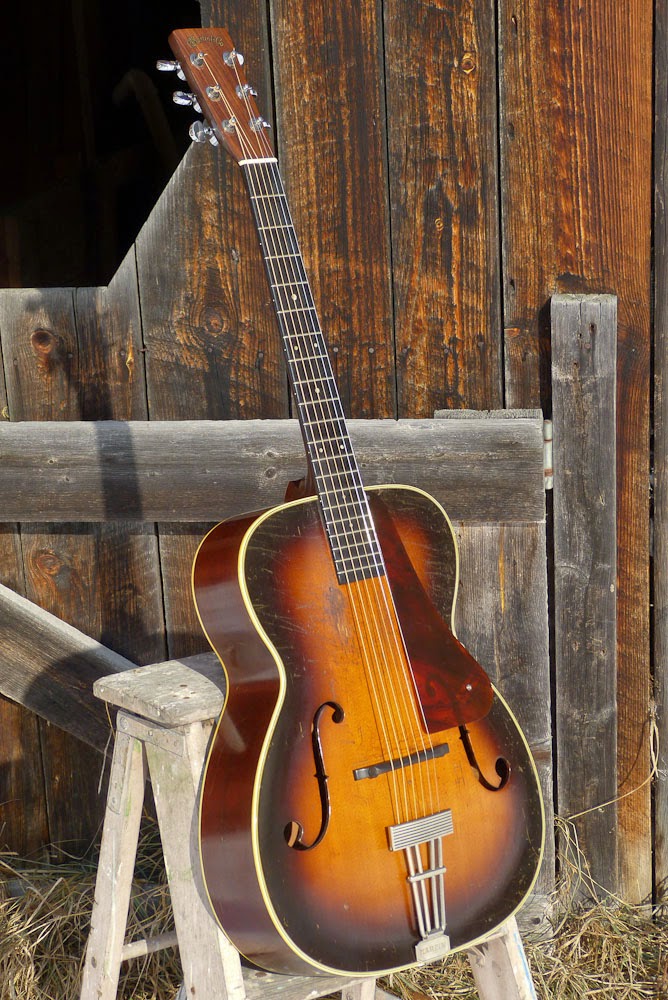1937 Martin C-1 Carved-top Archtop Guitar
Martin archtops are somewhat harder to find than other makes because they simply weren't made over as long a period or in as high numbers as, say, their Gibson competitors. If you look at production totals year-to-year, it's obvious that they weren't an unpopular choice. There's a mythos out there that Martin archtops are somewhat lacking or too-quiet but my experience is that they (and this) are just as good as any other quality make from the time and going head-to-head with a Gibson of similar specs this guitar has more to offer by way of enhanced lower mids and a slightly stingier treble, though it's not as compressed/snappy in a narrow band. Compared to a similar Epiphone, this guitar takes back all the warmth that Epis cast-off to get their attack and zing, but doesn't have the same fire on the high end. To my ears... this is a perfect third option.
This guitar was sent in for repair and my work included a fret level/dress, putting together a new bridge topper/saddle, setup, minor cleaning, and addition of a vintage pickguard bracket (it had a modern one on, and as usual, the modern one was far too tall and bulky). When I strung it up I was quite glad to see that the relatively thin, mild-v neck didn't deflect at all. It's perfectly straight and this allows the guitar to play with spot-on, 3/32" bass and 1/16" treble action. Despite the longer 25.4-ish scale (which I usually don't like for myself), it feels light to the touch.
This instrument's certainly been played and shows a lot of pickwear on the upper bout. The classy sunburst still holds onto all of its glory, however.
The top is solid (carved) spruce while the neck, back and sides are solid mahogany. Both the bridge and board are ebony. As has been mentioned in other places around the web... you can essentially think of this model as an archtop version of a 000 body. That's how it feels in the lap and hands.
Original bone nut... and big old modern tuners. Oh well!
At some point this headstock was cracked and reglued. The back of it was then oversprayed with a weird brown tint to hide it. The tuners must've been put on around the same time. They work well but I prefer the non-bulky uncovered tuners from the time.
The board is ebony and radiused. This instrument has original T-frets that leveled and dressed-up easily and quickly. There simply wasn't a whole lot of wear on them.
Isn't that binding great? The outer thick edge is ivoroid with the grained pattern in it.
I'm not sure if the pickguard is original or not: the mounting hardware isn't. The good thing about it is that the color looks great, it's the right shape, and it's a good, thick slab so it will take advancing years well.
The base and wheels of this bridge are original but the top isn't. I put that one together as the replacement (modern) top was simply not going to work with Martin's contrarian bridge design (it has ebony thumbwheels, of all things).
The heavy-duty Grover tail with Martin's stamp just screams luxury...
...as do those f-holes. Who doesn't like that cut? It's so clean and violin-world.
Don't mind the snow... it was (thankfully, for the first time in a week of 5-10 degree F days) warmer and sunny when I took the pics.
The back is "flat" like your average Martin flattop guitar's, rather than carved like the top. Great issue has been taken with this by armchair astronauts as to whether or not it's a good thing for the guitar.
Sheesh, really? I sometimes think that folks should go out and play these guitars rather than write about them. If anything, it's adding to the rich low-end response this guitar has.
Here's that sort-of mucky headstock overspray. You don't notice it at first, though.
I'm assuming the neck was reset some time ago... or it's just stayed in place. Either way, the angle is perfect.
I've always liked the look of a sunburst top mated to dark-stained mahogany sides. Gibson did this for some time in the 30s and I just like "seeing that red" while I'm playing.
Here you can see the curious ebony adjuster wheels a little better. My bridge topper is the same radius and height as the broken original, but is a bit bulkier like a modern archtop saddle. Hopefully it'll hold up better over time.





















Comments